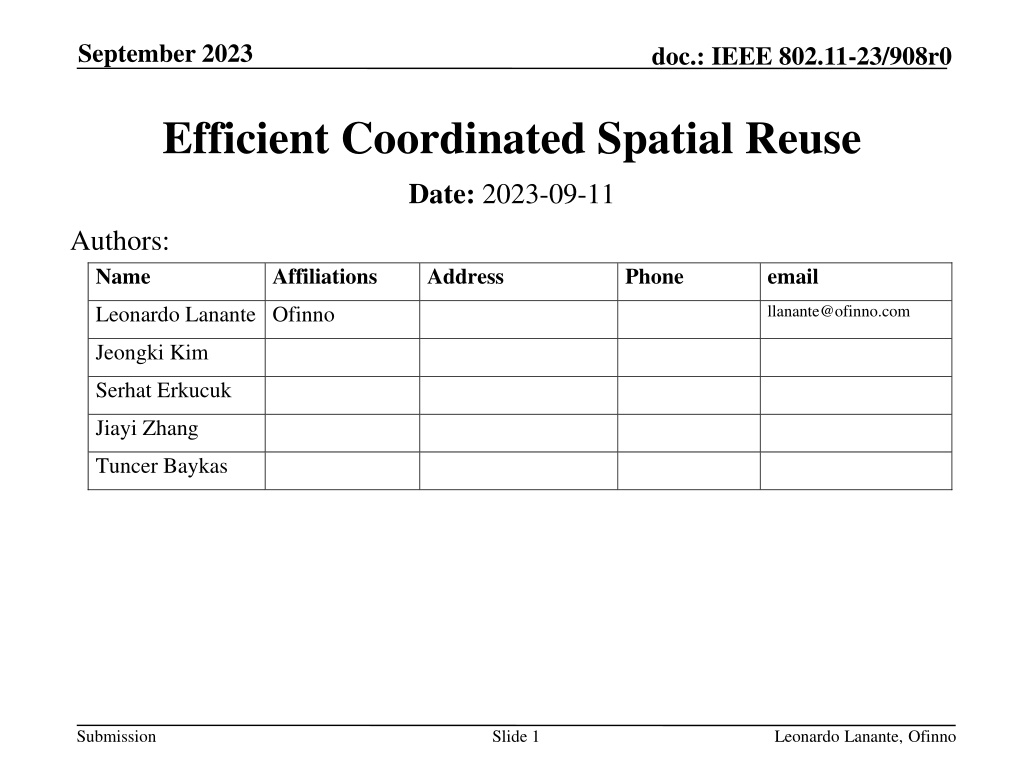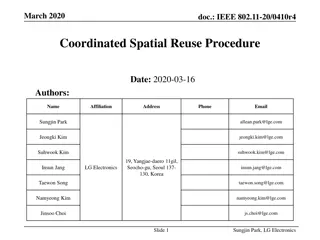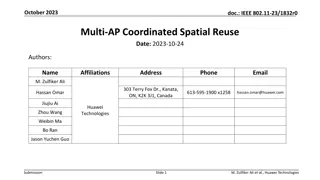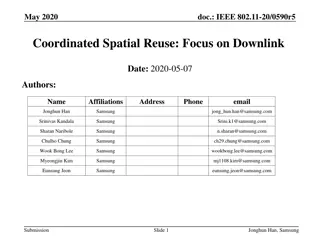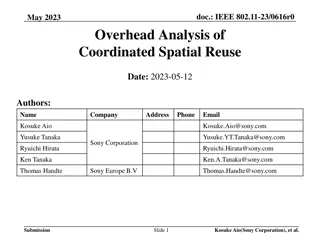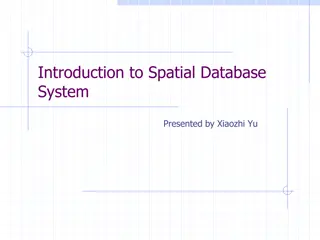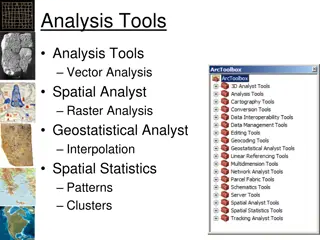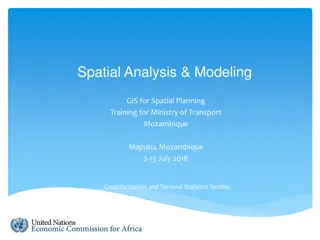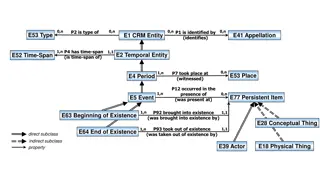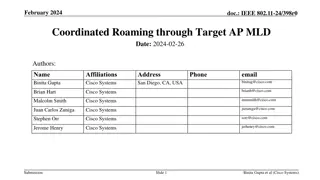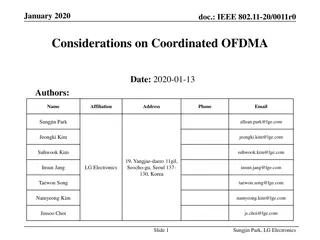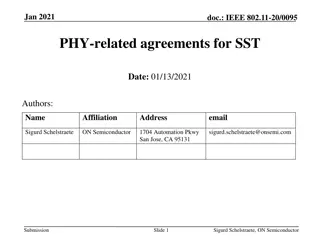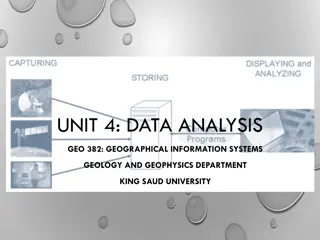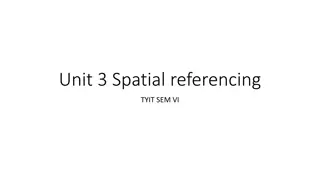Efficient Coordinated Spatial Reuse in IEEE 802.11-23
Coordinated Spatial Reuse (C-SR) is a Multi-AP transmission technique proposed for UHR networks that enhances efficiency by utilizing RSSI or pathloss feedback instead of complete CSI. This document introduces an efficient protocol for C-SR, focusing on a unified approach for better implementation. It discusses the general procedure for C-SR, shared AP transmit power and MCS determination, and methods for interference measurement and feedback collection to optimize transmission performance.
Download Presentation

Please find below an Image/Link to download the presentation.
The content on the website is provided AS IS for your information and personal use only. It may not be sold, licensed, or shared on other websites without obtaining consent from the author. Download presentation by click this link. If you encounter any issues during the download, it is possible that the publisher has removed the file from their server.
E N D
Presentation Transcript
September 2023 doc.: IEEE 802.11-23/908r0 Efficient Coordinated Spatial Reuse Date: 2023-09-11 Authors: Name Affiliations Address Phone email llanante@ofinno.com Leonardo Lanante Ofinno Jeongki Kim Serhat Erkucuk Jiayi Zhang Tuncer Baykas Submission Slide 1 Leonardo Lanante, Ofinno
September 2023 doc.: IEEE 802.11-23/908r0 Abstract Coordinated Spatial Reuse (C-SR) is one of the Multi-AP transmission techniques that is being considered for UHR. C-SR only requires RSSI or pathloss feedback as opposed to complete CSI between all APs and STAs. C-SR can be implemented using the protocols used for CBF and JT [1],[2]. A unified multi-AP protocol is preferred but may not be the most efficient especially for C-SR. In this contribution, we propose an efficient protocol for C-SR. Submission Slide 2 Leonardo Lanante, Ofinno
September 2023 doc.: IEEE 802.11-23/908r0 General Procedure for C-SR AP1 (sharing AP) AP2 Interference Measurement Phase Transmission Phase (shared AP) STA1 (Associated with AP1) STA2 (Associated with AP2) 1. Interference measurement phase The sharing/shared APs measure interference or pathloss to each other s target STA. 2. Transmission phase Initiated by the sharing AP. The sharing AP controls the transmit power and MCS of the shared APs. Submission Slide 3 Leonardo Lanante, Ofinno
September 2023 doc.: IEEE 802.11-23/908r0 Shared AP Transmit Power and MCS During the transmission phase, we assume that AP1 first decides its own transmit power and MCS. Based on these decisions, it computes the transmit power and MCS of the shared AP. Transmit power of AP2- AP2 transmit power depends on the interference from AP2 to STA1 (X2). MCS of AP2- The sharing AP (AP1) may indicate a maximum MCS of the shared AP. The MCS depends on the interference from AP1 to STA2 (X1). Problem: While X1 can be measured directly by AP1, X2 needs to be obtained from either AP2 or STA1. Submission Slide 4 Leonardo Lanante, Ofinno
September 2023 doc.: IEEE 802.11-23/908r0 Interference Measurement Phase and Feedback Collection AP1 MAP TF AP1 BFRP NDP NDPA MAP TF BFRP NDPA* measure X1 (sharing AP) (sharing AP) AP2 AP2 NDPA NDP measure X2 NDPA* BFR X2 (shared AP) (shared AP) STA1 (Associated with AP1) measure X2 STA1 (Associated with AP1) BFR X2 NDP measure X1 BFR X1 NDP STA2 (Associated with AP2) STA2 (Associated with AP2) Option 1 Option 2 - There are two options to obtain X1 and X2. Both options require the same number of steps. For option 2, only X2 needs to be transferred (marginally more efficient). We prefer a way where neither X1 nor X2 needs to be transferred, i.e. eliminate final BFRP-BFR exchange. - - Submission Slide 5 Leonardo Lanante, Ofinno
September 2023 doc.: IEEE 802.11-23/908r0 Proposed C-SR transmission method AP1 MAP TF DL Data Frame MAP TF NDPA* measure X1 (sharing AP) TP=f(X2,ARIL) AP2 measure X2 NDPA* DL Data Frame (shared AP) MCS,ARIL STA1 (Associated with AP1) BA NDP BA NDP STA2 (Associated with AP2) Interference Measurement Phase (Option 2) Transmission Phase - - - We propose that the MAP TF does not directly indicate TP for the shared AP. Instead, the MAP TF indicate an acceptable interference level (ARIL) parameter. The shared AP can determine its transmit power based on the ARIL and its own measured X2. Works well with Option 2 of Interference Measurement Phase. How to apply the same concept for Option 1 interference measurement phase is TBD. - Submission Slide 6 Leonardo Lanante, Ofinno
September 2023 doc.: IEEE 802.11-23/908r0 Example ARIL=-80 dBm AP1 MAP TF DL Data Frame MAP TF NDPA* (sharing AP) TP=ARIL+20-X2= 10 dBm AP2 STA1 Pathloss =90 dB AP2 NDPA* DL Data Frame X2 = -70 dBm MCS, ARIL (shared AP) STA1 (Associated with AP1) IL = -80 dBm BA NDP 20 dBm BA NDP STA2 (Associated with AP2) - The example shows how the sharing AP can control the interference of the shared AP without directly indicating the transmit power. The transmit power of the PPDU (NDP) where X2 was measured needs to be known by AP2. How to signal this is TBD. - Submission Slide 7 Leonardo Lanante, Ofinno
September 2023 doc.: IEEE 802.11-23/908r0 Benefits of the proposed CSR method - Very low overhead. - Simple implementation very similar to PSR-based SR transmit power determination. - Distributed processing. Allow shared APs to compute parameters by themselves to reduce interference measurement procedure overhead. Submission Slide 8 Leonardo Lanante, Ofinno
September 2023 doc.: IEEE 802.11-23/908r0 Conclusion We discussed a way to reduce the overhead of CSR by simply changing the transmit power signaling by the Sharing AP to the Shared AP. The proposed method may require a specific interference measurement procedure to achieve the most gain. Submission Slide 9 Leonardo Lanante, Ofinno
September 2023 doc.: IEEE 802.11-23/908r0 References [1] https://mentor.ieee.org/802.11/dcn/19/11-19-1097-00- 00be-sounding-procedure-in-ap-collaboration.pptx [2] https://mentor.ieee.org/802.11/dcn/19/11-19-1134-01- 00be-consideration-of-multi-ap-sounding.pptx Submission Slide 10 Leonardo Lanante, Ofinno
